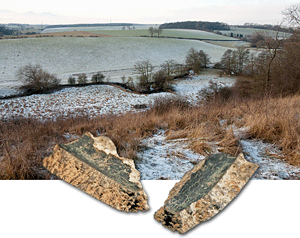
On one of Britain's most famous battlefields, early gun fragments hint at a new style of warfare

Two fragments found on the Towton battlefield are from the earliest guns to have been discovered in England on the site of a known conflict. Analysis has shown that at least one of the guns was fired, probably during the battle.
(Courtesy Roger Keech & Tim Sutherland/Towton Battlefield Archaeology Project)
On a snowy Palm Sunday morning, March 29, 1461, two armies met between the villages of Towton and Saxton in North Yorkshire, England. At stake was nothing less than control of the English throne. By the end of the next day, the Battle of Towton, as it came to be known, was over. Thousands of soldiers were dead, and the decades-long Wars of the Roses had reached a turning point. The House of Lancaster, led by King Henry VI, was routed by the forces of the House of York, which soon assumed control of England under King Edward IV. Although the actual number of casualties is a matter of scholarly debate, the Battle of Towton is often called Britain's bloodiest battle.
When Tim Sutherland of the Towton Battlefield Archaeology Project began digging at the site more than a decade ago, he expected to find the usual artifacts of medieval warfare--arrowheads, horse fittings, spurs, and graves. What he did not expect to find was evidence of new developments in armament technology that would eventually change the way that subsequent battles and wars were fought.
On what is believed to be the Lancastrian side of the battlefield, Sutherland found the remains of two guns, the earliest firearms found on the site of a known battlefield in Britain, and possibly Europe.

To read more, find ARCHAEOLOGY in your local newsstand or bookstore, or click here to buy a copy of the issue online. And if you'd like to receive ARCHAEOLOGY in your mailbox, click here to subscribe.
Jarrett A. Lobell is executive editor of ARCHAEOLOGY.
Advertisement

Advertisement







